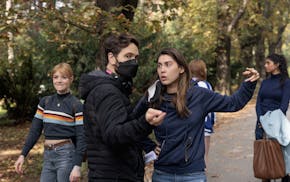By mid-May, trees in parts of Minnetonka and Richfield will be sprayed to eliminate gypsy moths found in both communities last summer.
To pick the best time for the treatment, the Minnesota Department of Agriculture has been tracking gypsy moth egg hatchings, which began in southern Wisconsin last week, said Lucy Hunt, supervisor of the state's gypsy moth unit.
In Richfield and Minnetonka, the department will watch for signs of hatching caterpillars in eggs collected in those communities and now contained in cages.
Spray timing is critical because the caterpillars must hatch and be actively eating to ingest the bacteria that will be sprayed on tree leaves, Hunt said.
Last summer about 60 moths were found in Minnetonka and 19 in Richfield. Because the leaf-eating insects can strip a tree of its foliage, weakening if not killing it, the goal is to eliminate the insects in their caterpillar stage, before they become adult moths.
On a day with calm winds, high humidity and no rain, department helicopters will start at sunrise to spray trees over 303 acres in Minnetonka and 382 acres in Richfield. In Minnetonka the area is south of Hwy. 7 and west of Interstate 494. In Richfield, the target area is west of I-35W between W. 72nd St. and 65th St.
"We want high humidity to prevent the evaporation of the material before it gets to the trees," Hunt said.
Residents in the affected areas will receive a postcard during the next two weeks reminding them of the spraying. Estimated cost of the application is $35 an acre.
The moths travel when they are caterpillars by climbing to a high place, sending out a strand of silk and sailing as far as a mile on the wind, Hunt said. But they are also "expert hitch-hikers" and travel from state to state on camping gear or as people move household goods, she said.
That is what the department thinks happened in Richfield and Minnetonka.
Minnesota has "no known established populations with reproducing life cycles," Hunt said. "What we have is an isolated hot spot here and there."
Because the moths have a predictable life cycle, with all the eggs hatching and all the caterpillars emerging at the same time, eradication efforts have been successful, Hunt said.
The department will know by October if the treatment worked in Richfield and Minnetonka by putting out traps for adult moths. "We are targeting the baby caterpillars. If none of them survive, we shouldn't see any adults," Hunt said. "If the area is clean, we will know it's a successful treatment."
The bacteria used in the spray are common in soil and considered harmless to people, animals and other insects.
Minnesota has been battling the spread of the moth since 1973. While gypsy moths are now common in much of Wisconsin, Minnesota has managed to beat back a permanent infestation.
The department monitors the eastern third of the state every year and the entire state every three to four years, using more than 21,000 traps statewide, Hunt said.
Gypsy moths were introduced to America from Europe in the 1860s in an attempt to breed a hardier silkworm, according to the department. The caterpillars escaped, with disastrous effects.
For more information on gypsy moths, call the Department of Agriculture Arrest the Pest Hotline at 651-201-6684 or 1-888-545-6684, or go to www.dnr.state.mn.us/invasives.
Laurie Blake • 612-673-1711

Chaska native's directorial debut 'Tarot' will be in 3,500 theaters
